Analysis of Myer Holdings Limited
VerifiedAdded on 2023/01/18
|17
|3014
|68
AI Summary
This paper provides a critical analysis of the annual report of Myer Holdings Limited based on its annual report in 2016. It covers business risks, results of analytical procedures, inherent risks, key accounts at risk, and planning materiality.
Contribute Materials
Your contribution can guide someone’s learning journey. Share your
documents today.
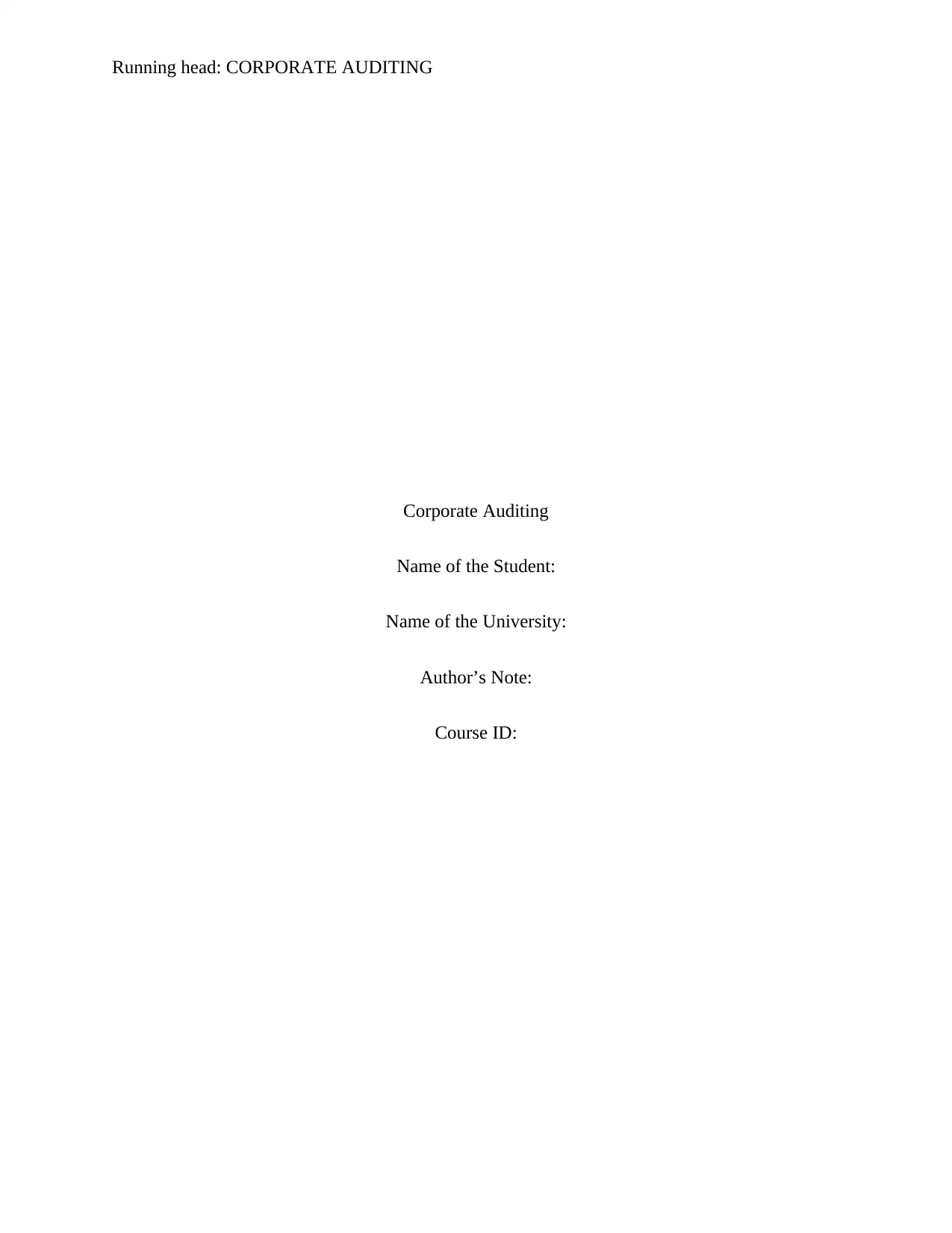
Running head: CORPORATE AUDITING
Corporate Auditing
Name of the Student:
Name of the University:
Author’s Note:
Course ID:
Corporate Auditing
Name of the Student:
Name of the University:
Author’s Note:
Course ID:
Secure Best Marks with AI Grader
Need help grading? Try our AI Grader for instant feedback on your assignments.
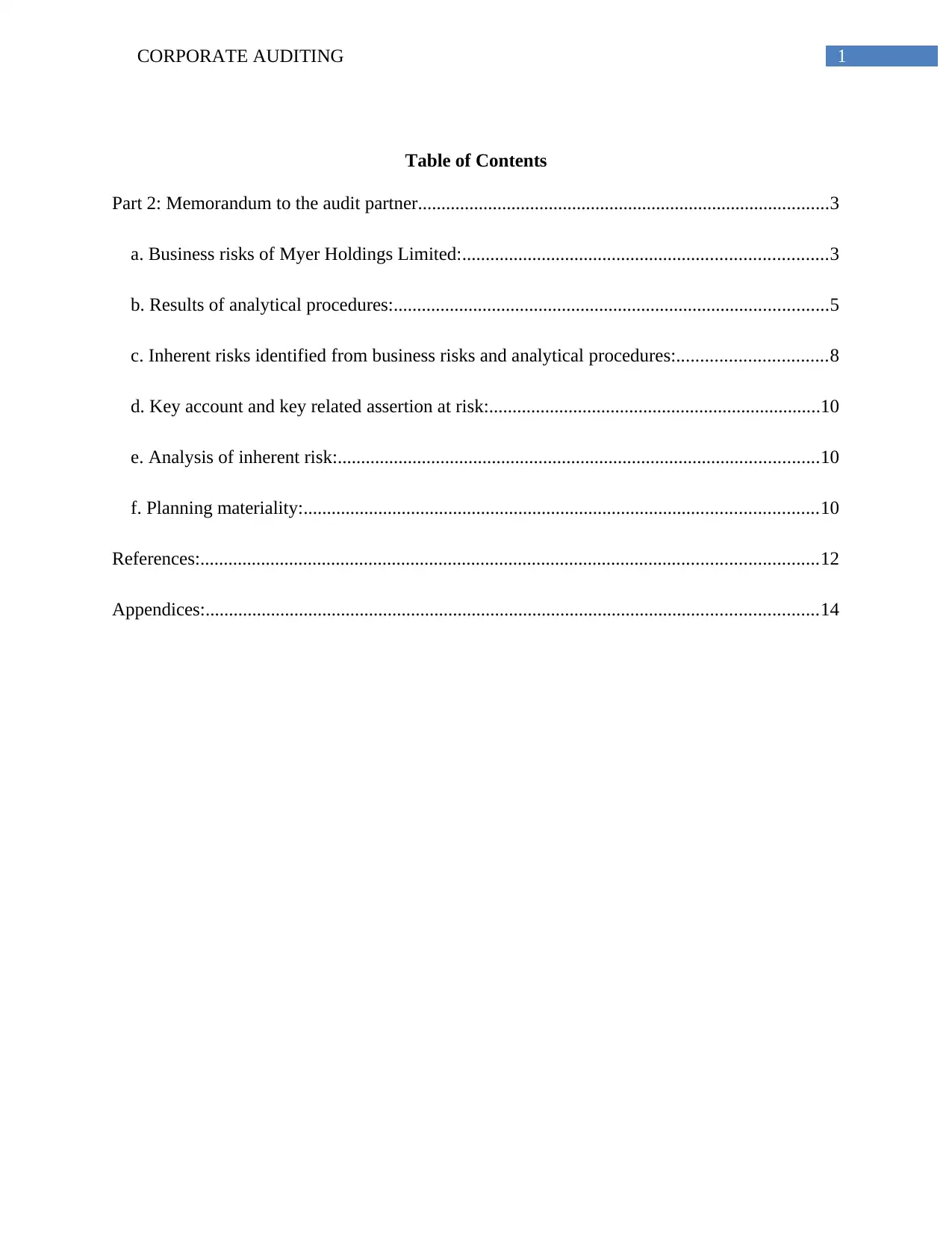
1CORPORATE AUDITING
Table of Contents
Part 2: Memorandum to the audit partner........................................................................................3
a. Business risks of Myer Holdings Limited:..............................................................................3
b. Results of analytical procedures:.............................................................................................5
c. Inherent risks identified from business risks and analytical procedures:................................8
d. Key account and key related assertion at risk:.......................................................................10
e. Analysis of inherent risk:.......................................................................................................10
f. Planning materiality:..............................................................................................................10
References:....................................................................................................................................12
Appendices:...................................................................................................................................14
Table of Contents
Part 2: Memorandum to the audit partner........................................................................................3
a. Business risks of Myer Holdings Limited:..............................................................................3
b. Results of analytical procedures:.............................................................................................5
c. Inherent risks identified from business risks and analytical procedures:................................8
d. Key account and key related assertion at risk:.......................................................................10
e. Analysis of inherent risk:.......................................................................................................10
f. Planning materiality:..............................................................................................................10
References:....................................................................................................................................12
Appendices:...................................................................................................................................14
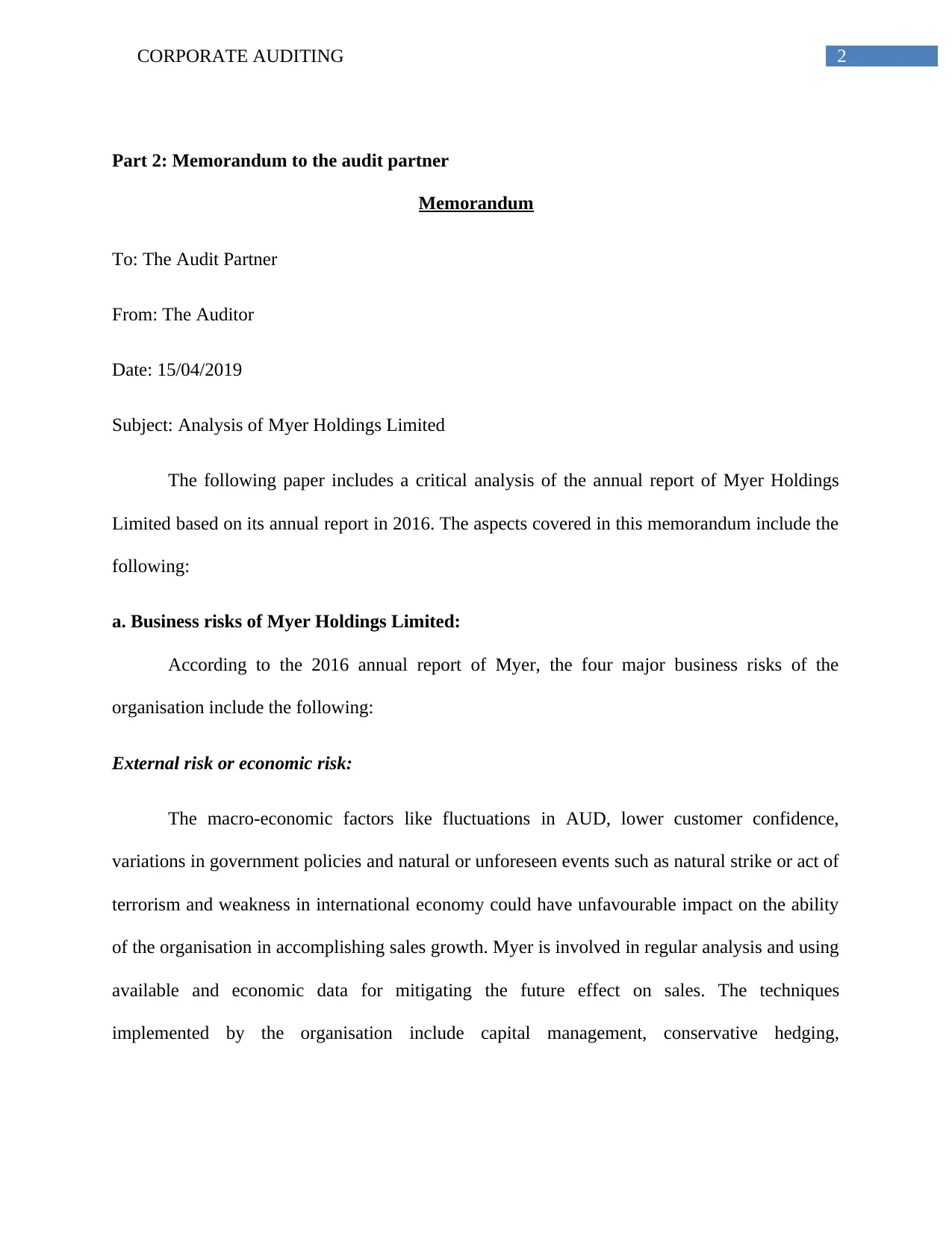
2CORPORATE AUDITING
Part 2: Memorandum to the audit partner
Memorandum
To: The Audit Partner
From: The Auditor
Date: 15/04/2019
Subject: Analysis of Myer Holdings Limited
The following paper includes a critical analysis of the annual report of Myer Holdings
Limited based on its annual report in 2016. The aspects covered in this memorandum include the
following:
a. Business risks of Myer Holdings Limited:
According to the 2016 annual report of Myer, the four major business risks of the
organisation include the following:
External risk or economic risk:
The macro-economic factors like fluctuations in AUD, lower customer confidence,
variations in government policies and natural or unforeseen events such as natural strike or act of
terrorism and weakness in international economy could have unfavourable impact on the ability
of the organisation in accomplishing sales growth. Myer is involved in regular analysis and using
available and economic data for mitigating the future effect on sales. The techniques
implemented by the organisation include capital management, conservative hedging,
Part 2: Memorandum to the audit partner
Memorandum
To: The Audit Partner
From: The Auditor
Date: 15/04/2019
Subject: Analysis of Myer Holdings Limited
The following paper includes a critical analysis of the annual report of Myer Holdings
Limited based on its annual report in 2016. The aspects covered in this memorandum include the
following:
a. Business risks of Myer Holdings Limited:
According to the 2016 annual report of Myer, the four major business risks of the
organisation include the following:
External risk or economic risk:
The macro-economic factors like fluctuations in AUD, lower customer confidence,
variations in government policies and natural or unforeseen events such as natural strike or act of
terrorism and weakness in international economy could have unfavourable impact on the ability
of the organisation in accomplishing sales growth. Myer is involved in regular analysis and using
available and economic data for mitigating the future effect on sales. The techniques
implemented by the organisation include capital management, conservative hedging,
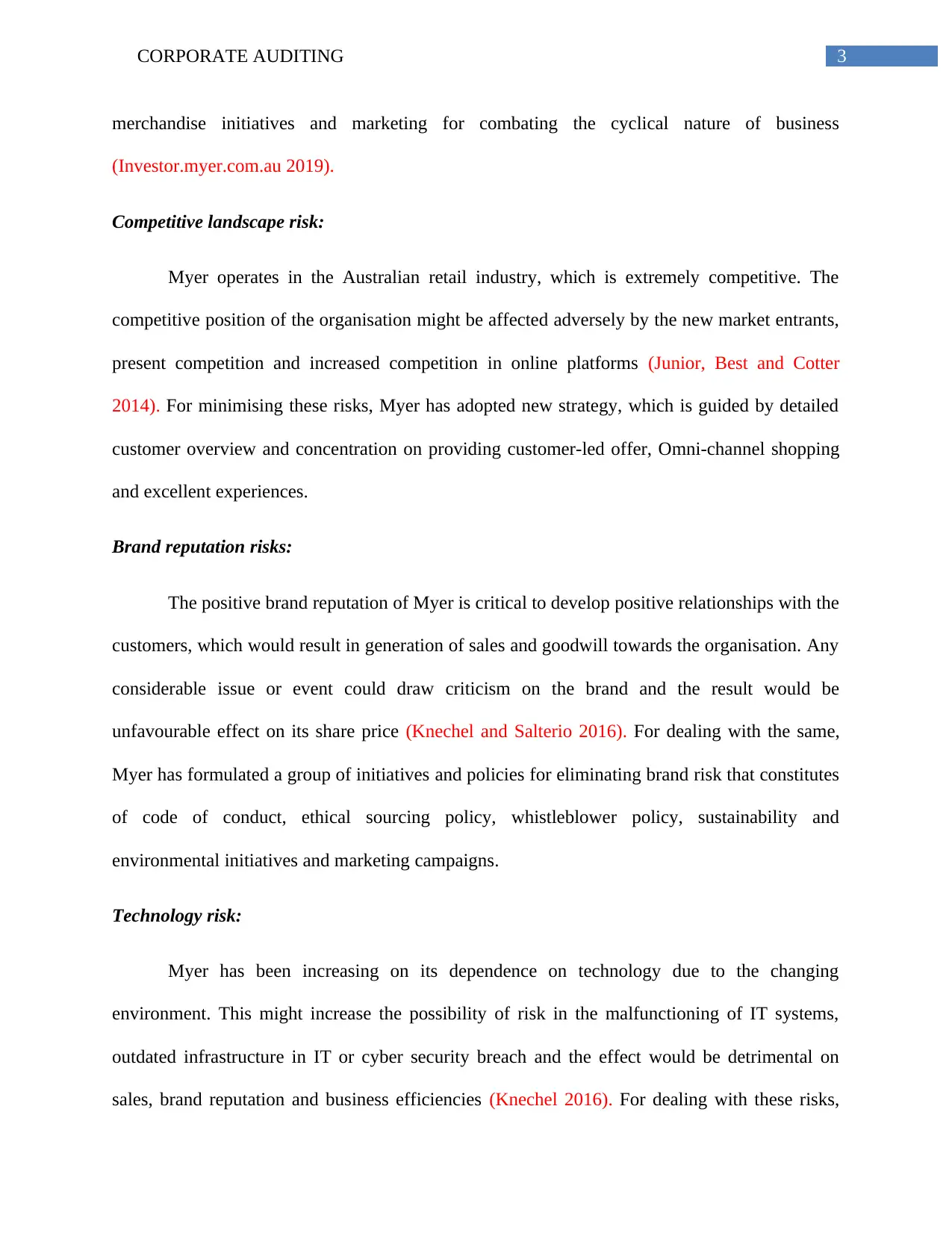
3CORPORATE AUDITING
merchandise initiatives and marketing for combating the cyclical nature of business
(Investor.myer.com.au 2019).
Competitive landscape risk:
Myer operates in the Australian retail industry, which is extremely competitive. The
competitive position of the organisation might be affected adversely by the new market entrants,
present competition and increased competition in online platforms (Junior, Best and Cotter
2014). For minimising these risks, Myer has adopted new strategy, which is guided by detailed
customer overview and concentration on providing customer-led offer, Omni-channel shopping
and excellent experiences.
Brand reputation risks:
The positive brand reputation of Myer is critical to develop positive relationships with the
customers, which would result in generation of sales and goodwill towards the organisation. Any
considerable issue or event could draw criticism on the brand and the result would be
unfavourable effect on its share price (Knechel and Salterio 2016). For dealing with the same,
Myer has formulated a group of initiatives and policies for eliminating brand risk that constitutes
of code of conduct, ethical sourcing policy, whistleblower policy, sustainability and
environmental initiatives and marketing campaigns.
Technology risk:
Myer has been increasing on its dependence on technology due to the changing
environment. This might increase the possibility of risk in the malfunctioning of IT systems,
outdated infrastructure in IT or cyber security breach and the effect would be detrimental on
sales, brand reputation and business efficiencies (Knechel 2016). For dealing with these risks,
merchandise initiatives and marketing for combating the cyclical nature of business
(Investor.myer.com.au 2019).
Competitive landscape risk:
Myer operates in the Australian retail industry, which is extremely competitive. The
competitive position of the organisation might be affected adversely by the new market entrants,
present competition and increased competition in online platforms (Junior, Best and Cotter
2014). For minimising these risks, Myer has adopted new strategy, which is guided by detailed
customer overview and concentration on providing customer-led offer, Omni-channel shopping
and excellent experiences.
Brand reputation risks:
The positive brand reputation of Myer is critical to develop positive relationships with the
customers, which would result in generation of sales and goodwill towards the organisation. Any
considerable issue or event could draw criticism on the brand and the result would be
unfavourable effect on its share price (Knechel and Salterio 2016). For dealing with the same,
Myer has formulated a group of initiatives and policies for eliminating brand risk that constitutes
of code of conduct, ethical sourcing policy, whistleblower policy, sustainability and
environmental initiatives and marketing campaigns.
Technology risk:
Myer has been increasing on its dependence on technology due to the changing
environment. This might increase the possibility of risk in the malfunctioning of IT systems,
outdated infrastructure in IT or cyber security breach and the effect would be detrimental on
sales, brand reputation and business efficiencies (Knechel 2016). For dealing with these risks,
Secure Best Marks with AI Grader
Need help grading? Try our AI Grader for instant feedback on your assignments.
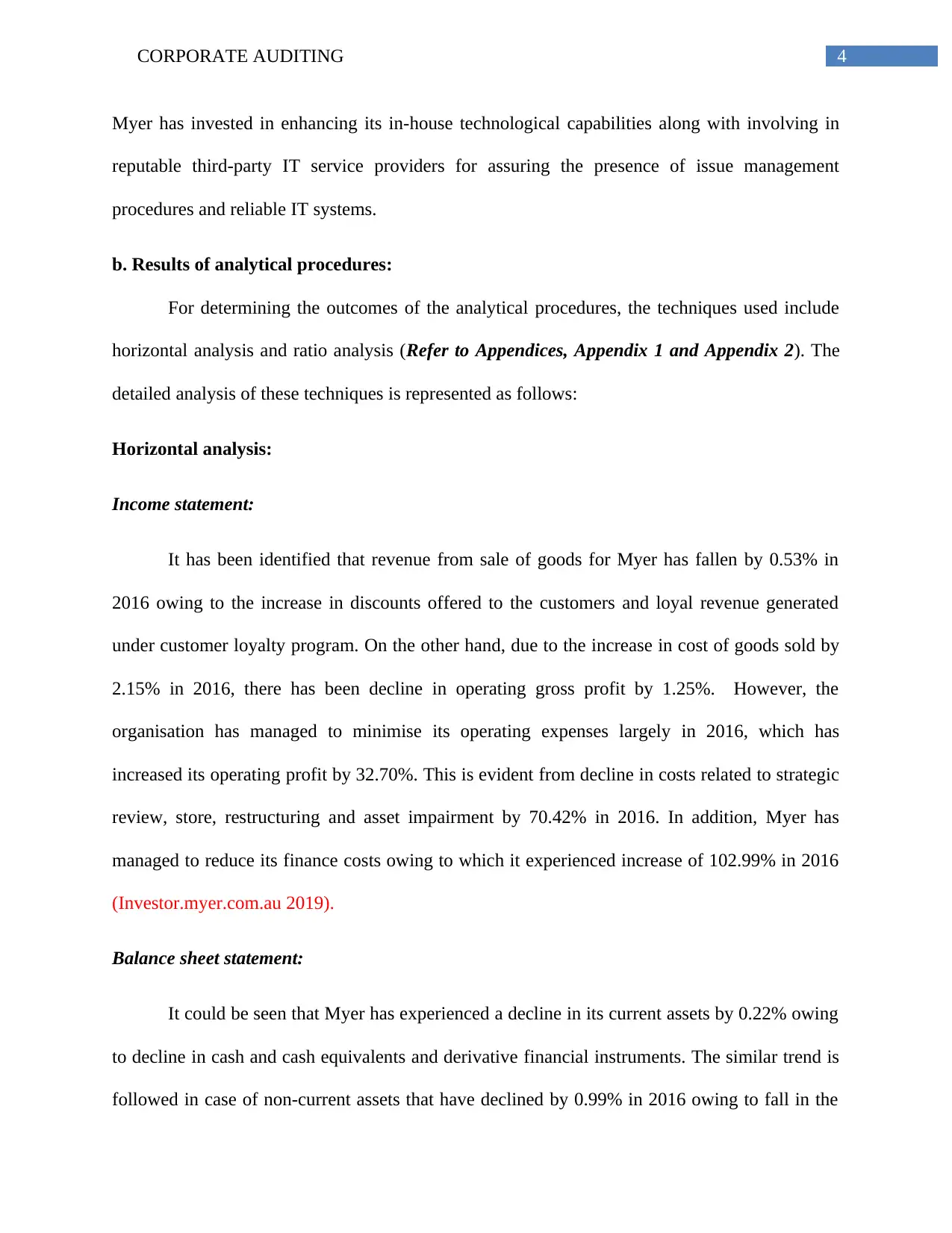
4CORPORATE AUDITING
Myer has invested in enhancing its in-house technological capabilities along with involving in
reputable third-party IT service providers for assuring the presence of issue management
procedures and reliable IT systems.
b. Results of analytical procedures:
For determining the outcomes of the analytical procedures, the techniques used include
horizontal analysis and ratio analysis (Refer to Appendices, Appendix 1 and Appendix 2). The
detailed analysis of these techniques is represented as follows:
Horizontal analysis:
Income statement:
It has been identified that revenue from sale of goods for Myer has fallen by 0.53% in
2016 owing to the increase in discounts offered to the customers and loyal revenue generated
under customer loyalty program. On the other hand, due to the increase in cost of goods sold by
2.15% in 2016, there has been decline in operating gross profit by 1.25%. However, the
organisation has managed to minimise its operating expenses largely in 2016, which has
increased its operating profit by 32.70%. This is evident from decline in costs related to strategic
review, store, restructuring and asset impairment by 70.42% in 2016. In addition, Myer has
managed to reduce its finance costs owing to which it experienced increase of 102.99% in 2016
(Investor.myer.com.au 2019).
Balance sheet statement:
It could be seen that Myer has experienced a decline in its current assets by 0.22% owing
to decline in cash and cash equivalents and derivative financial instruments. The similar trend is
followed in case of non-current assets that have declined by 0.99% in 2016 owing to fall in the
Myer has invested in enhancing its in-house technological capabilities along with involving in
reputable third-party IT service providers for assuring the presence of issue management
procedures and reliable IT systems.
b. Results of analytical procedures:
For determining the outcomes of the analytical procedures, the techniques used include
horizontal analysis and ratio analysis (Refer to Appendices, Appendix 1 and Appendix 2). The
detailed analysis of these techniques is represented as follows:
Horizontal analysis:
Income statement:
It has been identified that revenue from sale of goods for Myer has fallen by 0.53% in
2016 owing to the increase in discounts offered to the customers and loyal revenue generated
under customer loyalty program. On the other hand, due to the increase in cost of goods sold by
2.15% in 2016, there has been decline in operating gross profit by 1.25%. However, the
organisation has managed to minimise its operating expenses largely in 2016, which has
increased its operating profit by 32.70%. This is evident from decline in costs related to strategic
review, store, restructuring and asset impairment by 70.42% in 2016. In addition, Myer has
managed to reduce its finance costs owing to which it experienced increase of 102.99% in 2016
(Investor.myer.com.au 2019).
Balance sheet statement:
It could be seen that Myer has experienced a decline in its current assets by 0.22% owing
to decline in cash and cash equivalents and derivative financial instruments. The similar trend is
followed in case of non-current assets that have declined by 0.99% in 2016 owing to fall in the
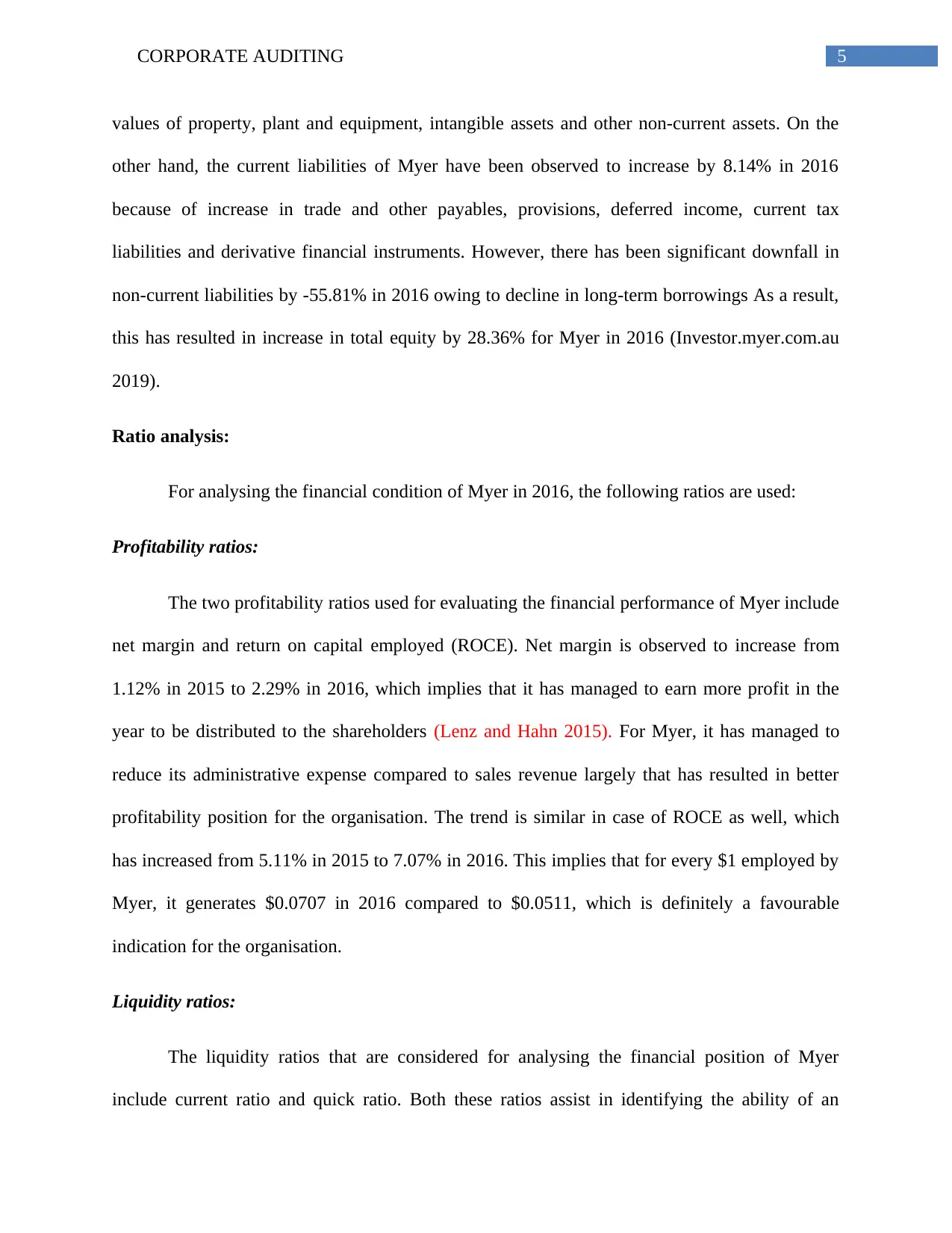
5CORPORATE AUDITING
values of property, plant and equipment, intangible assets and other non-current assets. On the
other hand, the current liabilities of Myer have been observed to increase by 8.14% in 2016
because of increase in trade and other payables, provisions, deferred income, current tax
liabilities and derivative financial instruments. However, there has been significant downfall in
non-current liabilities by -55.81% in 2016 owing to decline in long-term borrowings As a result,
this has resulted in increase in total equity by 28.36% for Myer in 2016 (Investor.myer.com.au
2019).
Ratio analysis:
For analysing the financial condition of Myer in 2016, the following ratios are used:
Profitability ratios:
The two profitability ratios used for evaluating the financial performance of Myer include
net margin and return on capital employed (ROCE). Net margin is observed to increase from
1.12% in 2015 to 2.29% in 2016, which implies that it has managed to earn more profit in the
year to be distributed to the shareholders (Lenz and Hahn 2015). For Myer, it has managed to
reduce its administrative expense compared to sales revenue largely that has resulted in better
profitability position for the organisation. The trend is similar in case of ROCE as well, which
has increased from 5.11% in 2015 to 7.07% in 2016. This implies that for every $1 employed by
Myer, it generates $0.0707 in 2016 compared to $0.0511, which is definitely a favourable
indication for the organisation.
Liquidity ratios:
The liquidity ratios that are considered for analysing the financial position of Myer
include current ratio and quick ratio. Both these ratios assist in identifying the ability of an
values of property, plant and equipment, intangible assets and other non-current assets. On the
other hand, the current liabilities of Myer have been observed to increase by 8.14% in 2016
because of increase in trade and other payables, provisions, deferred income, current tax
liabilities and derivative financial instruments. However, there has been significant downfall in
non-current liabilities by -55.81% in 2016 owing to decline in long-term borrowings As a result,
this has resulted in increase in total equity by 28.36% for Myer in 2016 (Investor.myer.com.au
2019).
Ratio analysis:
For analysing the financial condition of Myer in 2016, the following ratios are used:
Profitability ratios:
The two profitability ratios used for evaluating the financial performance of Myer include
net margin and return on capital employed (ROCE). Net margin is observed to increase from
1.12% in 2015 to 2.29% in 2016, which implies that it has managed to earn more profit in the
year to be distributed to the shareholders (Lenz and Hahn 2015). For Myer, it has managed to
reduce its administrative expense compared to sales revenue largely that has resulted in better
profitability position for the organisation. The trend is similar in case of ROCE as well, which
has increased from 5.11% in 2015 to 7.07% in 2016. This implies that for every $1 employed by
Myer, it generates $0.0707 in 2016 compared to $0.0511, which is definitely a favourable
indication for the organisation.
Liquidity ratios:
The liquidity ratios that are considered for analysing the financial position of Myer
include current ratio and quick ratio. Both these ratios assist in identifying the ability of an
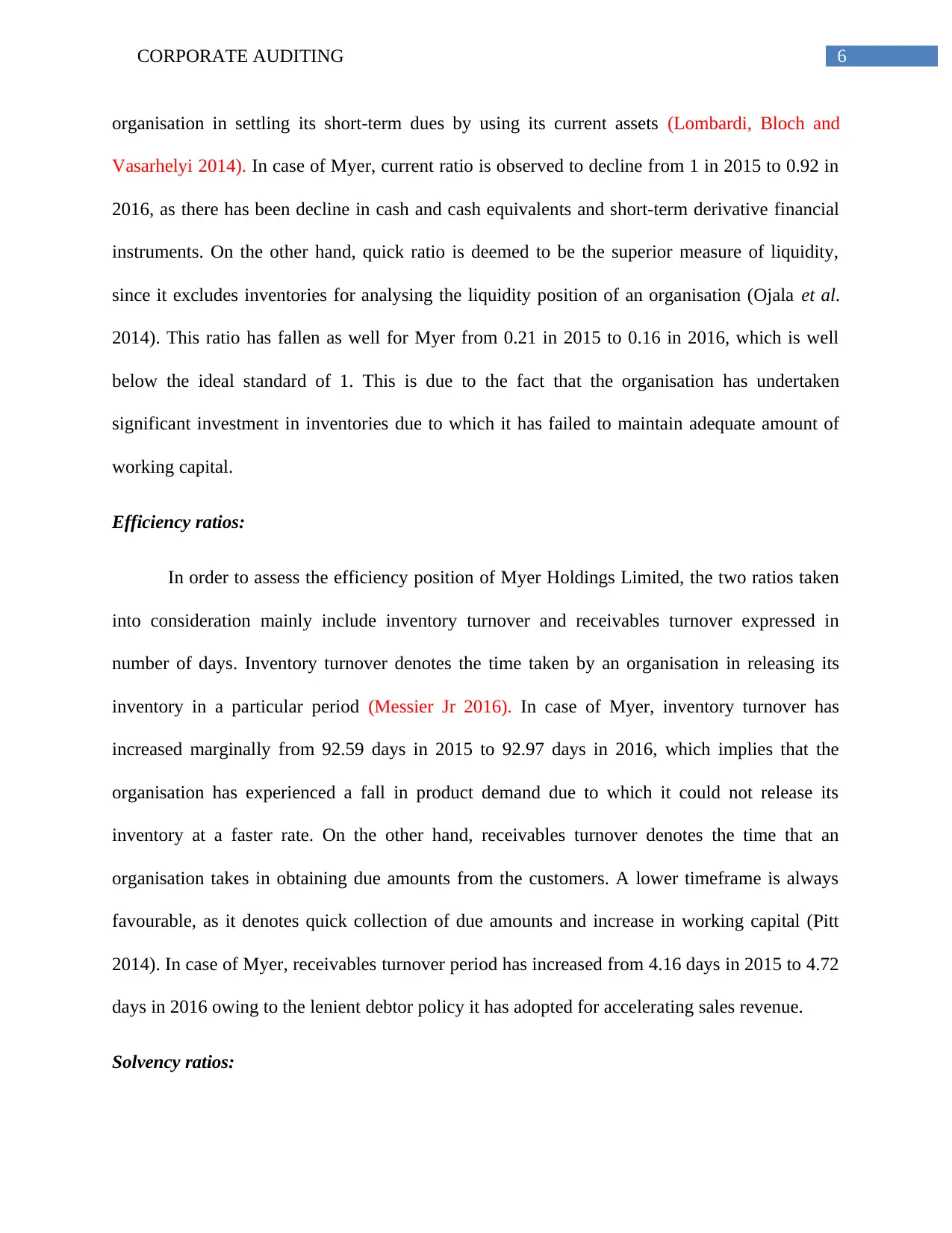
6CORPORATE AUDITING
organisation in settling its short-term dues by using its current assets (Lombardi, Bloch and
Vasarhelyi 2014). In case of Myer, current ratio is observed to decline from 1 in 2015 to 0.92 in
2016, as there has been decline in cash and cash equivalents and short-term derivative financial
instruments. On the other hand, quick ratio is deemed to be the superior measure of liquidity,
since it excludes inventories for analysing the liquidity position of an organisation (Ojala et al.
2014). This ratio has fallen as well for Myer from 0.21 in 2015 to 0.16 in 2016, which is well
below the ideal standard of 1. This is due to the fact that the organisation has undertaken
significant investment in inventories due to which it has failed to maintain adequate amount of
working capital.
Efficiency ratios:
In order to assess the efficiency position of Myer Holdings Limited, the two ratios taken
into consideration mainly include inventory turnover and receivables turnover expressed in
number of days. Inventory turnover denotes the time taken by an organisation in releasing its
inventory in a particular period (Messier Jr 2016). In case of Myer, inventory turnover has
increased marginally from 92.59 days in 2015 to 92.97 days in 2016, which implies that the
organisation has experienced a fall in product demand due to which it could not release its
inventory at a faster rate. On the other hand, receivables turnover denotes the time that an
organisation takes in obtaining due amounts from the customers. A lower timeframe is always
favourable, as it denotes quick collection of due amounts and increase in working capital (Pitt
2014). In case of Myer, receivables turnover period has increased from 4.16 days in 2015 to 4.72
days in 2016 owing to the lenient debtor policy it has adopted for accelerating sales revenue.
Solvency ratios:
organisation in settling its short-term dues by using its current assets (Lombardi, Bloch and
Vasarhelyi 2014). In case of Myer, current ratio is observed to decline from 1 in 2015 to 0.92 in
2016, as there has been decline in cash and cash equivalents and short-term derivative financial
instruments. On the other hand, quick ratio is deemed to be the superior measure of liquidity,
since it excludes inventories for analysing the liquidity position of an organisation (Ojala et al.
2014). This ratio has fallen as well for Myer from 0.21 in 2015 to 0.16 in 2016, which is well
below the ideal standard of 1. This is due to the fact that the organisation has undertaken
significant investment in inventories due to which it has failed to maintain adequate amount of
working capital.
Efficiency ratios:
In order to assess the efficiency position of Myer Holdings Limited, the two ratios taken
into consideration mainly include inventory turnover and receivables turnover expressed in
number of days. Inventory turnover denotes the time taken by an organisation in releasing its
inventory in a particular period (Messier Jr 2016). In case of Myer, inventory turnover has
increased marginally from 92.59 days in 2015 to 92.97 days in 2016, which implies that the
organisation has experienced a fall in product demand due to which it could not release its
inventory at a faster rate. On the other hand, receivables turnover denotes the time that an
organisation takes in obtaining due amounts from the customers. A lower timeframe is always
favourable, as it denotes quick collection of due amounts and increase in working capital (Pitt
2014). In case of Myer, receivables turnover period has increased from 4.16 days in 2015 to 4.72
days in 2016 owing to the lenient debtor policy it has adopted for accelerating sales revenue.
Solvency ratios:
Paraphrase This Document
Need a fresh take? Get an instant paraphrase of this document with our AI Paraphraser
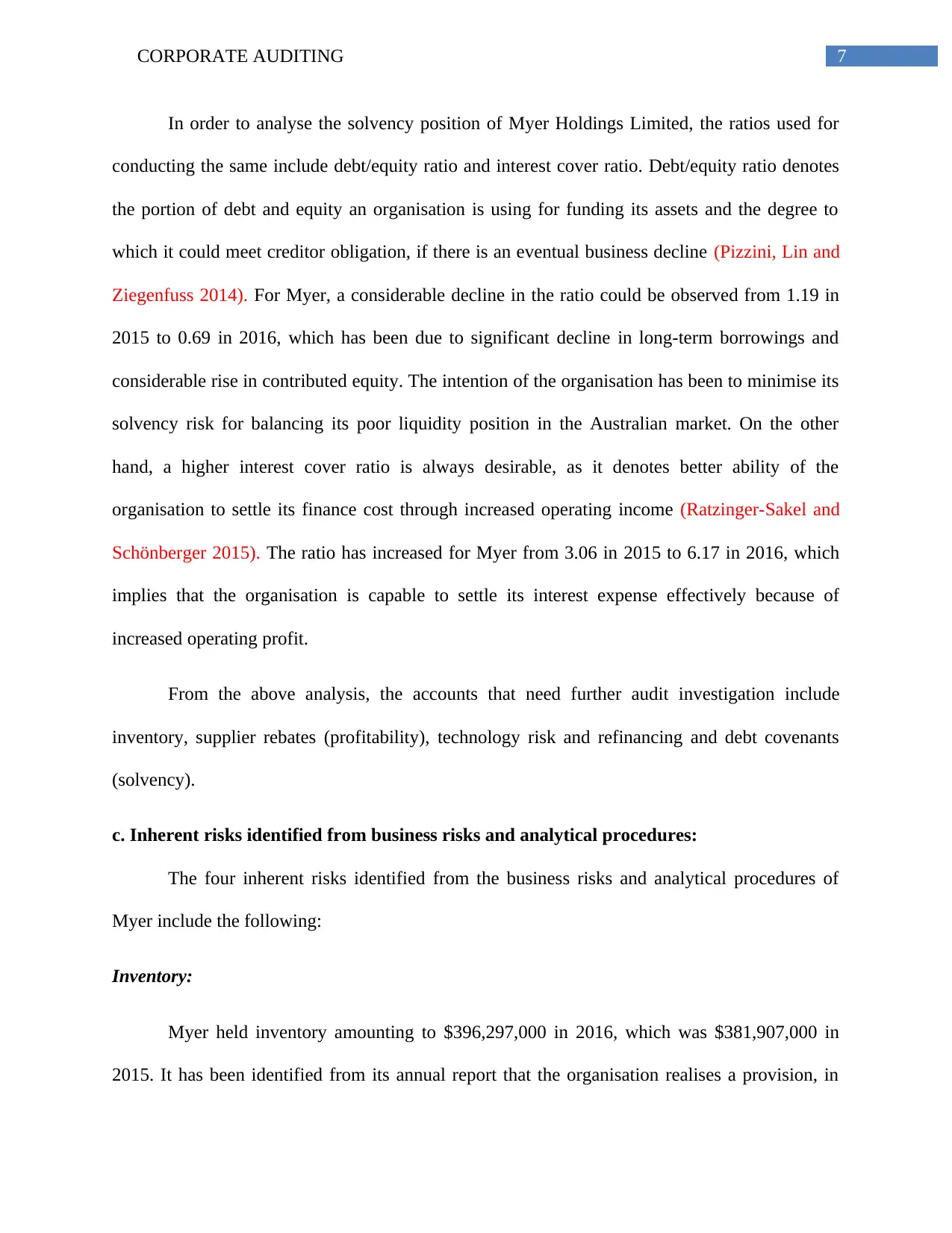
7CORPORATE AUDITING
In order to analyse the solvency position of Myer Holdings Limited, the ratios used for
conducting the same include debt/equity ratio and interest cover ratio. Debt/equity ratio denotes
the portion of debt and equity an organisation is using for funding its assets and the degree to
which it could meet creditor obligation, if there is an eventual business decline (Pizzini, Lin and
Ziegenfuss 2014). For Myer, a considerable decline in the ratio could be observed from 1.19 in
2015 to 0.69 in 2016, which has been due to significant decline in long-term borrowings and
considerable rise in contributed equity. The intention of the organisation has been to minimise its
solvency risk for balancing its poor liquidity position in the Australian market. On the other
hand, a higher interest cover ratio is always desirable, as it denotes better ability of the
organisation to settle its finance cost through increased operating income (Ratzinger-Sakel and
Schönberger 2015). The ratio has increased for Myer from 3.06 in 2015 to 6.17 in 2016, which
implies that the organisation is capable to settle its interest expense effectively because of
increased operating profit.
From the above analysis, the accounts that need further audit investigation include
inventory, supplier rebates (profitability), technology risk and refinancing and debt covenants
(solvency).
c. Inherent risks identified from business risks and analytical procedures:
The four inherent risks identified from the business risks and analytical procedures of
Myer include the following:
Inventory:
Myer held inventory amounting to $396,297,000 in 2016, which was $381,907,000 in
2015. It has been identified from its annual report that the organisation realises a provision, in
In order to analyse the solvency position of Myer Holdings Limited, the ratios used for
conducting the same include debt/equity ratio and interest cover ratio. Debt/equity ratio denotes
the portion of debt and equity an organisation is using for funding its assets and the degree to
which it could meet creditor obligation, if there is an eventual business decline (Pizzini, Lin and
Ziegenfuss 2014). For Myer, a considerable decline in the ratio could be observed from 1.19 in
2015 to 0.69 in 2016, which has been due to significant decline in long-term borrowings and
considerable rise in contributed equity. The intention of the organisation has been to minimise its
solvency risk for balancing its poor liquidity position in the Australian market. On the other
hand, a higher interest cover ratio is always desirable, as it denotes better ability of the
organisation to settle its finance cost through increased operating income (Ratzinger-Sakel and
Schönberger 2015). The ratio has increased for Myer from 3.06 in 2015 to 6.17 in 2016, which
implies that the organisation is capable to settle its interest expense effectively because of
increased operating profit.
From the above analysis, the accounts that need further audit investigation include
inventory, supplier rebates (profitability), technology risk and refinancing and debt covenants
(solvency).
c. Inherent risks identified from business risks and analytical procedures:
The four inherent risks identified from the business risks and analytical procedures of
Myer include the following:
Inventory:
Myer held inventory amounting to $396,297,000 in 2016, which was $381,907,000 in
2015. It has been identified from its annual report that the organisation realises a provision, in
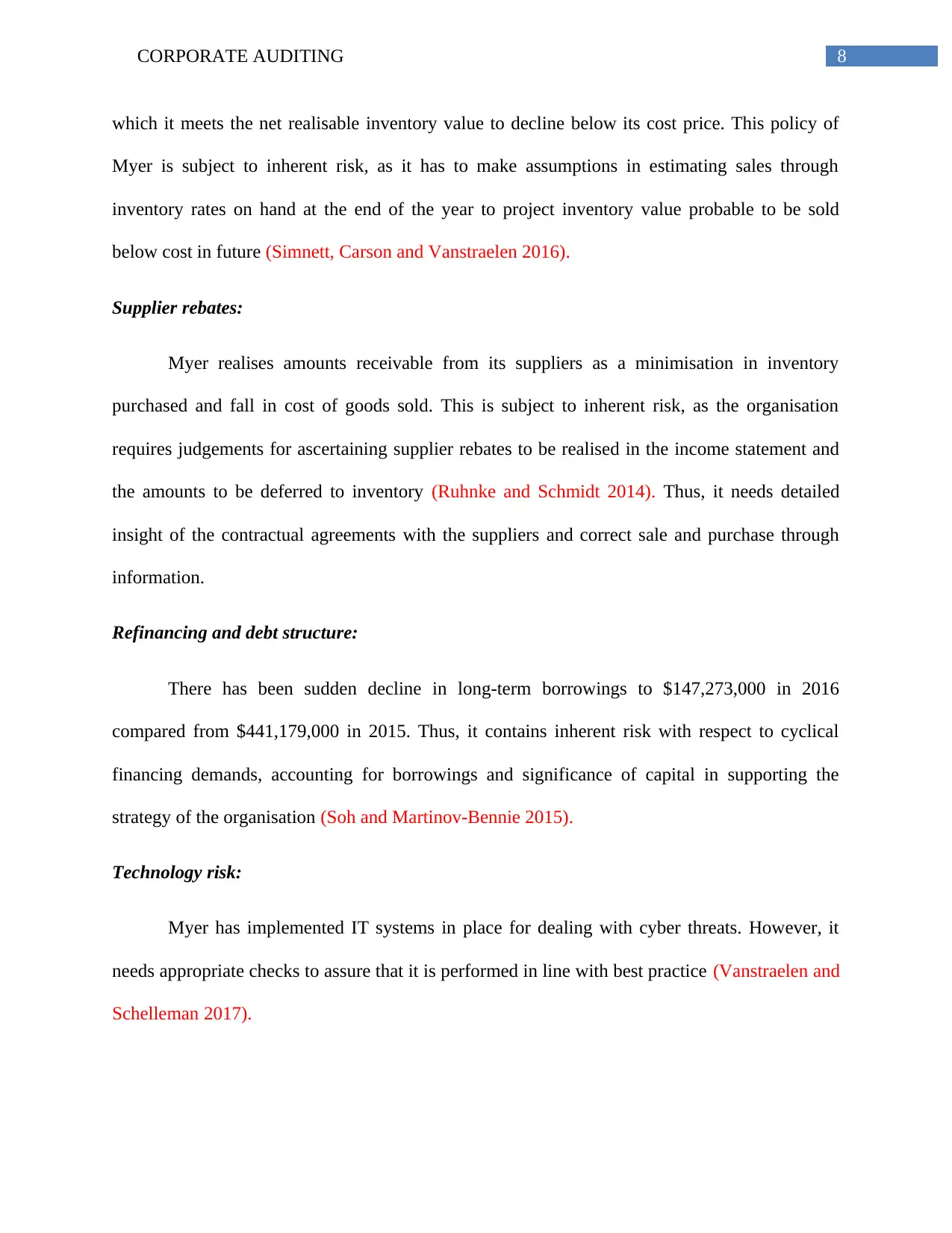
8CORPORATE AUDITING
which it meets the net realisable inventory value to decline below its cost price. This policy of
Myer is subject to inherent risk, as it has to make assumptions in estimating sales through
inventory rates on hand at the end of the year to project inventory value probable to be sold
below cost in future (Simnett, Carson and Vanstraelen 2016).
Supplier rebates:
Myer realises amounts receivable from its suppliers as a minimisation in inventory
purchased and fall in cost of goods sold. This is subject to inherent risk, as the organisation
requires judgements for ascertaining supplier rebates to be realised in the income statement and
the amounts to be deferred to inventory (Ruhnke and Schmidt 2014). Thus, it needs detailed
insight of the contractual agreements with the suppliers and correct sale and purchase through
information.
Refinancing and debt structure:
There has been sudden decline in long-term borrowings to $147,273,000 in 2016
compared from $441,179,000 in 2015. Thus, it contains inherent risk with respect to cyclical
financing demands, accounting for borrowings and significance of capital in supporting the
strategy of the organisation (Soh and Martinov-Bennie 2015).
Technology risk:
Myer has implemented IT systems in place for dealing with cyber threats. However, it
needs appropriate checks to assure that it is performed in line with best practice (Vanstraelen and
Schelleman 2017).
which it meets the net realisable inventory value to decline below its cost price. This policy of
Myer is subject to inherent risk, as it has to make assumptions in estimating sales through
inventory rates on hand at the end of the year to project inventory value probable to be sold
below cost in future (Simnett, Carson and Vanstraelen 2016).
Supplier rebates:
Myer realises amounts receivable from its suppliers as a minimisation in inventory
purchased and fall in cost of goods sold. This is subject to inherent risk, as the organisation
requires judgements for ascertaining supplier rebates to be realised in the income statement and
the amounts to be deferred to inventory (Ruhnke and Schmidt 2014). Thus, it needs detailed
insight of the contractual agreements with the suppliers and correct sale and purchase through
information.
Refinancing and debt structure:
There has been sudden decline in long-term borrowings to $147,273,000 in 2016
compared from $441,179,000 in 2015. Thus, it contains inherent risk with respect to cyclical
financing demands, accounting for borrowings and significance of capital in supporting the
strategy of the organisation (Soh and Martinov-Bennie 2015).
Technology risk:
Myer has implemented IT systems in place for dealing with cyber threats. However, it
needs appropriate checks to assure that it is performed in line with best practice (Vanstraelen and
Schelleman 2017).
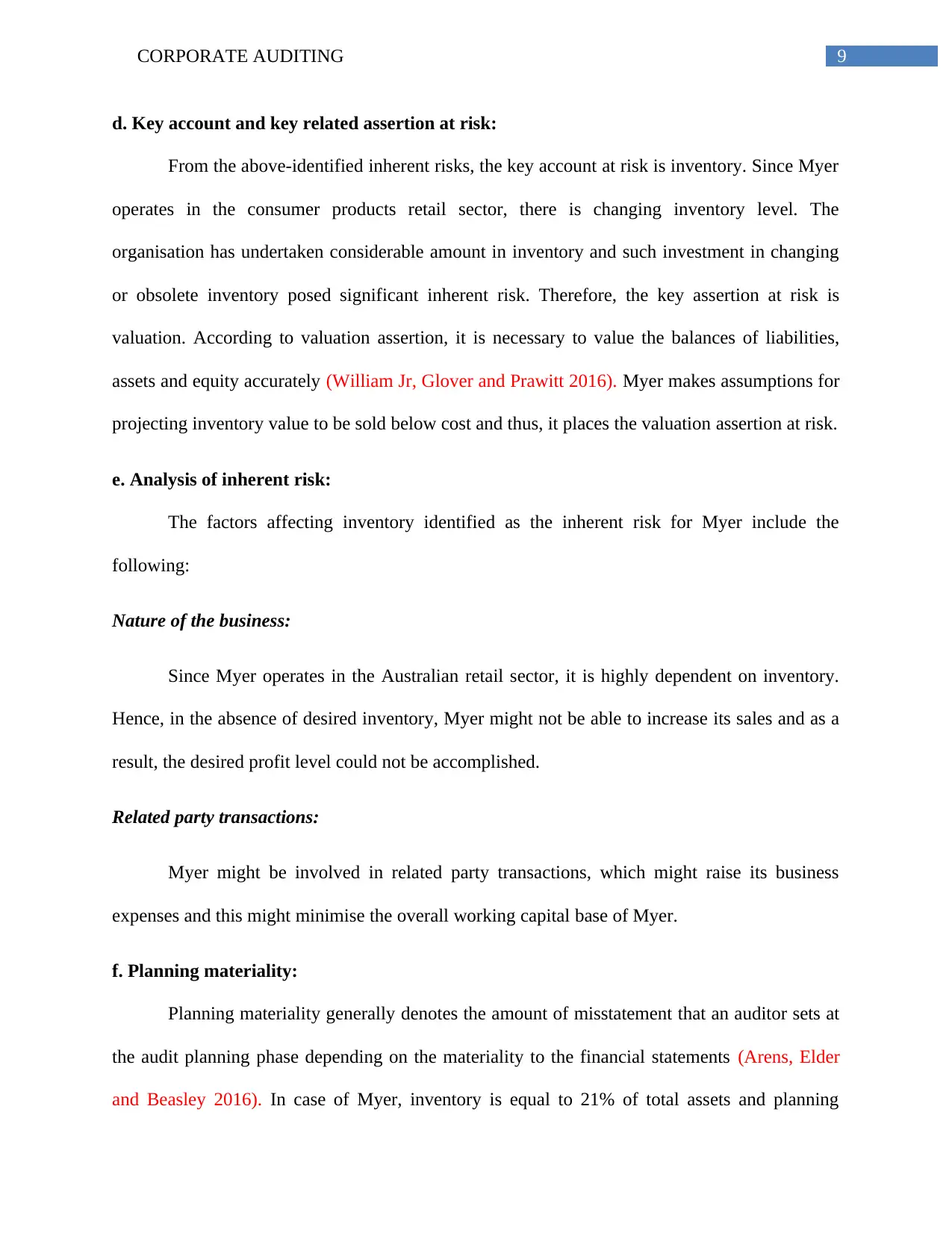
9CORPORATE AUDITING
d. Key account and key related assertion at risk:
From the above-identified inherent risks, the key account at risk is inventory. Since Myer
operates in the consumer products retail sector, there is changing inventory level. The
organisation has undertaken considerable amount in inventory and such investment in changing
or obsolete inventory posed significant inherent risk. Therefore, the key assertion at risk is
valuation. According to valuation assertion, it is necessary to value the balances of liabilities,
assets and equity accurately (William Jr, Glover and Prawitt 2016). Myer makes assumptions for
projecting inventory value to be sold below cost and thus, it places the valuation assertion at risk.
e. Analysis of inherent risk:
The factors affecting inventory identified as the inherent risk for Myer include the
following:
Nature of the business:
Since Myer operates in the Australian retail sector, it is highly dependent on inventory.
Hence, in the absence of desired inventory, Myer might not be able to increase its sales and as a
result, the desired profit level could not be accomplished.
Related party transactions:
Myer might be involved in related party transactions, which might raise its business
expenses and this might minimise the overall working capital base of Myer.
f. Planning materiality:
Planning materiality generally denotes the amount of misstatement that an auditor sets at
the audit planning phase depending on the materiality to the financial statements (Arens, Elder
and Beasley 2016). In case of Myer, inventory is equal to 21% of total assets and planning
d. Key account and key related assertion at risk:
From the above-identified inherent risks, the key account at risk is inventory. Since Myer
operates in the consumer products retail sector, there is changing inventory level. The
organisation has undertaken considerable amount in inventory and such investment in changing
or obsolete inventory posed significant inherent risk. Therefore, the key assertion at risk is
valuation. According to valuation assertion, it is necessary to value the balances of liabilities,
assets and equity accurately (William Jr, Glover and Prawitt 2016). Myer makes assumptions for
projecting inventory value to be sold below cost and thus, it places the valuation assertion at risk.
e. Analysis of inherent risk:
The factors affecting inventory identified as the inherent risk for Myer include the
following:
Nature of the business:
Since Myer operates in the Australian retail sector, it is highly dependent on inventory.
Hence, in the absence of desired inventory, Myer might not be able to increase its sales and as a
result, the desired profit level could not be accomplished.
Related party transactions:
Myer might be involved in related party transactions, which might raise its business
expenses and this might minimise the overall working capital base of Myer.
f. Planning materiality:
Planning materiality generally denotes the amount of misstatement that an auditor sets at
the audit planning phase depending on the materiality to the financial statements (Arens, Elder
and Beasley 2016). In case of Myer, inventory is equal to 21% of total assets and planning
Secure Best Marks with AI Grader
Need help grading? Try our AI Grader for instant feedback on your assignments.
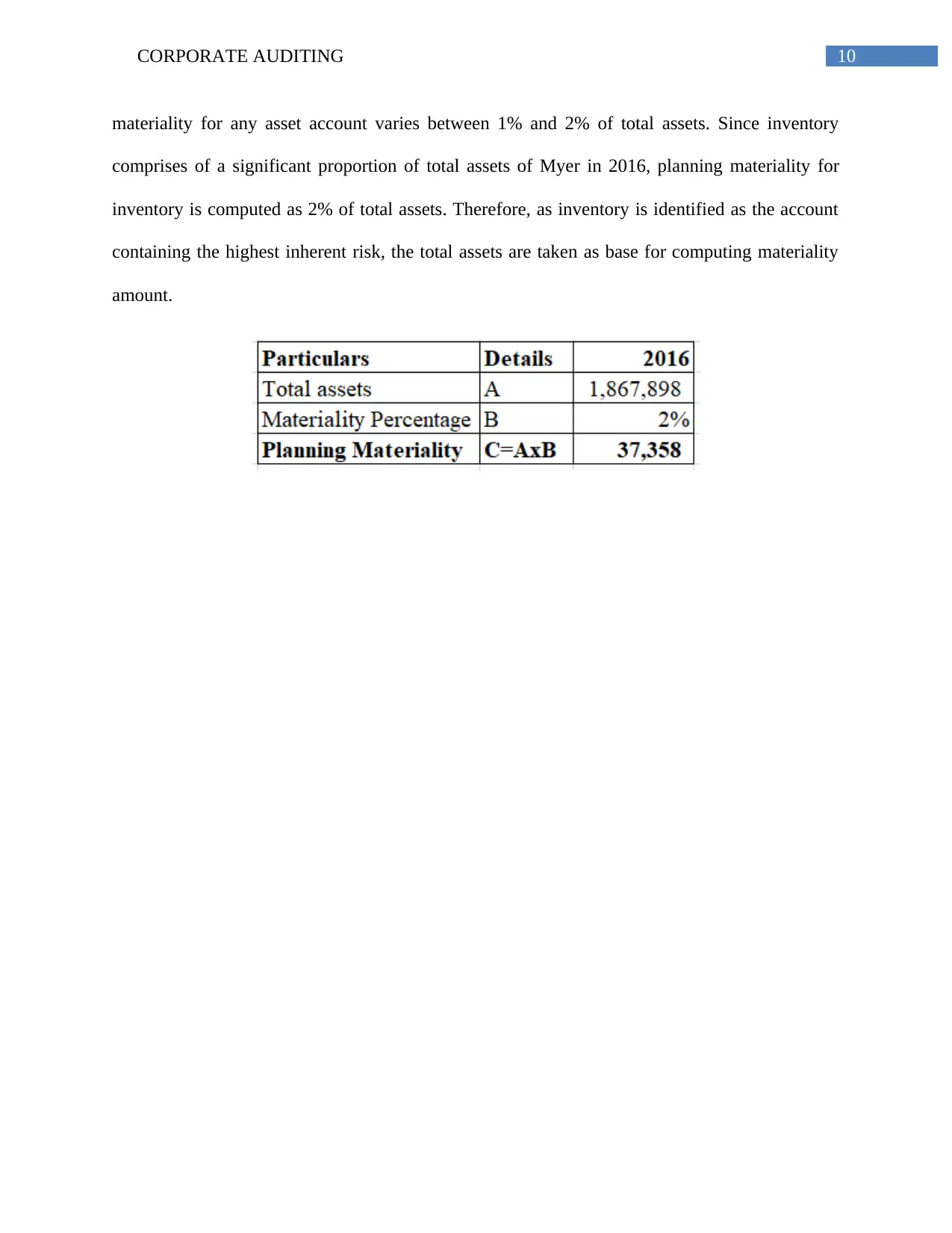
10CORPORATE AUDITING
materiality for any asset account varies between 1% and 2% of total assets. Since inventory
comprises of a significant proportion of total assets of Myer in 2016, planning materiality for
inventory is computed as 2% of total assets. Therefore, as inventory is identified as the account
containing the highest inherent risk, the total assets are taken as base for computing materiality
amount.
materiality for any asset account varies between 1% and 2% of total assets. Since inventory
comprises of a significant proportion of total assets of Myer in 2016, planning materiality for
inventory is computed as 2% of total assets. Therefore, as inventory is identified as the account
containing the highest inherent risk, the total assets are taken as base for computing materiality
amount.
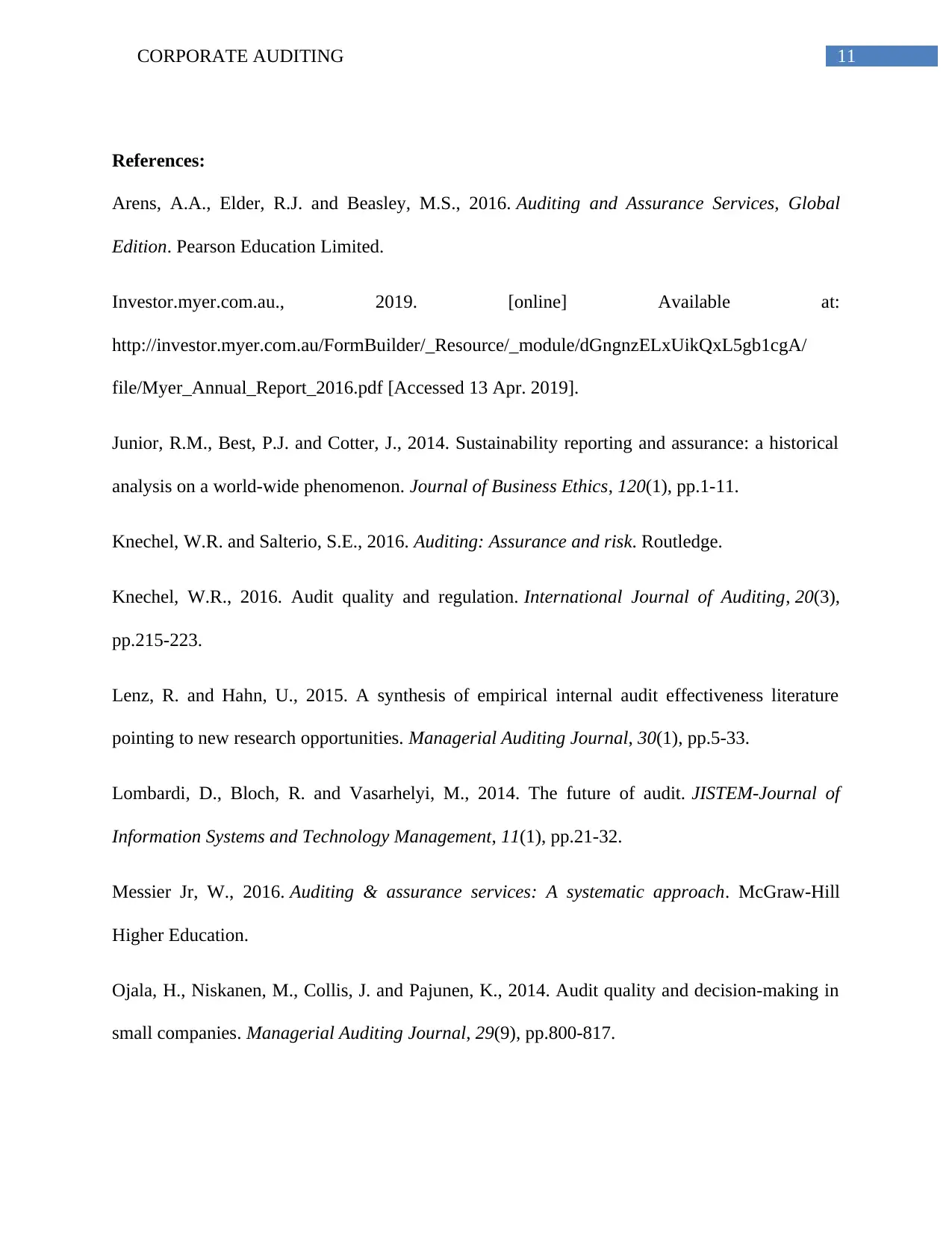
11CORPORATE AUDITING
References:
Arens, A.A., Elder, R.J. and Beasley, M.S., 2016. Auditing and Assurance Services, Global
Edition. Pearson Education Limited.
Investor.myer.com.au., 2019. [online] Available at:
http://investor.myer.com.au/FormBuilder/_Resource/_module/dGngnzELxUikQxL5gb1cgA/
file/Myer_Annual_Report_2016.pdf [Accessed 13 Apr. 2019].
Junior, R.M., Best, P.J. and Cotter, J., 2014. Sustainability reporting and assurance: a historical
analysis on a world-wide phenomenon. Journal of Business Ethics, 120(1), pp.1-11.
Knechel, W.R. and Salterio, S.E., 2016. Auditing: Assurance and risk. Routledge.
Knechel, W.R., 2016. Audit quality and regulation. International Journal of Auditing, 20(3),
pp.215-223.
Lenz, R. and Hahn, U., 2015. A synthesis of empirical internal audit effectiveness literature
pointing to new research opportunities. Managerial Auditing Journal, 30(1), pp.5-33.
Lombardi, D., Bloch, R. and Vasarhelyi, M., 2014. The future of audit. JISTEM-Journal of
Information Systems and Technology Management, 11(1), pp.21-32.
Messier Jr, W., 2016. Auditing & assurance services: A systematic approach. McGraw-Hill
Higher Education.
Ojala, H., Niskanen, M., Collis, J. and Pajunen, K., 2014. Audit quality and decision-making in
small companies. Managerial Auditing Journal, 29(9), pp.800-817.
References:
Arens, A.A., Elder, R.J. and Beasley, M.S., 2016. Auditing and Assurance Services, Global
Edition. Pearson Education Limited.
Investor.myer.com.au., 2019. [online] Available at:
http://investor.myer.com.au/FormBuilder/_Resource/_module/dGngnzELxUikQxL5gb1cgA/
file/Myer_Annual_Report_2016.pdf [Accessed 13 Apr. 2019].
Junior, R.M., Best, P.J. and Cotter, J., 2014. Sustainability reporting and assurance: a historical
analysis on a world-wide phenomenon. Journal of Business Ethics, 120(1), pp.1-11.
Knechel, W.R. and Salterio, S.E., 2016. Auditing: Assurance and risk. Routledge.
Knechel, W.R., 2016. Audit quality and regulation. International Journal of Auditing, 20(3),
pp.215-223.
Lenz, R. and Hahn, U., 2015. A synthesis of empirical internal audit effectiveness literature
pointing to new research opportunities. Managerial Auditing Journal, 30(1), pp.5-33.
Lombardi, D., Bloch, R. and Vasarhelyi, M., 2014. The future of audit. JISTEM-Journal of
Information Systems and Technology Management, 11(1), pp.21-32.
Messier Jr, W., 2016. Auditing & assurance services: A systematic approach. McGraw-Hill
Higher Education.
Ojala, H., Niskanen, M., Collis, J. and Pajunen, K., 2014. Audit quality and decision-making in
small companies. Managerial Auditing Journal, 29(9), pp.800-817.
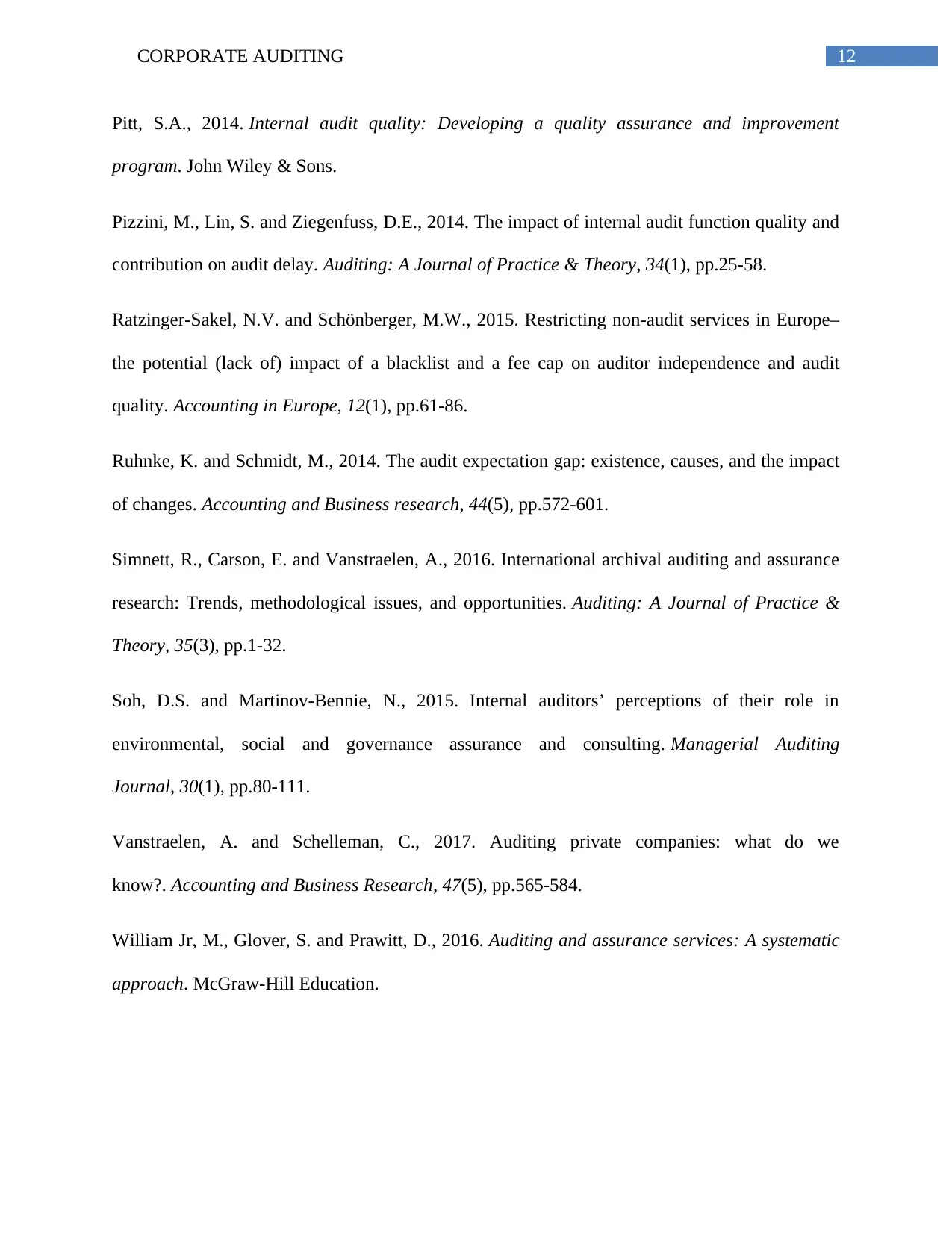
12CORPORATE AUDITING
Pitt, S.A., 2014. Internal audit quality: Developing a quality assurance and improvement
program. John Wiley & Sons.
Pizzini, M., Lin, S. and Ziegenfuss, D.E., 2014. The impact of internal audit function quality and
contribution on audit delay. Auditing: A Journal of Practice & Theory, 34(1), pp.25-58.
Ratzinger-Sakel, N.V. and Schönberger, M.W., 2015. Restricting non-audit services in Europe–
the potential (lack of) impact of a blacklist and a fee cap on auditor independence and audit
quality. Accounting in Europe, 12(1), pp.61-86.
Ruhnke, K. and Schmidt, M., 2014. The audit expectation gap: existence, causes, and the impact
of changes. Accounting and Business research, 44(5), pp.572-601.
Simnett, R., Carson, E. and Vanstraelen, A., 2016. International archival auditing and assurance
research: Trends, methodological issues, and opportunities. Auditing: A Journal of Practice &
Theory, 35(3), pp.1-32.
Soh, D.S. and Martinov-Bennie, N., 2015. Internal auditors’ perceptions of their role in
environmental, social and governance assurance and consulting. Managerial Auditing
Journal, 30(1), pp.80-111.
Vanstraelen, A. and Schelleman, C., 2017. Auditing private companies: what do we
know?. Accounting and Business Research, 47(5), pp.565-584.
William Jr, M., Glover, S. and Prawitt, D., 2016. Auditing and assurance services: A systematic
approach. McGraw-Hill Education.
Pitt, S.A., 2014. Internal audit quality: Developing a quality assurance and improvement
program. John Wiley & Sons.
Pizzini, M., Lin, S. and Ziegenfuss, D.E., 2014. The impact of internal audit function quality and
contribution on audit delay. Auditing: A Journal of Practice & Theory, 34(1), pp.25-58.
Ratzinger-Sakel, N.V. and Schönberger, M.W., 2015. Restricting non-audit services in Europe–
the potential (lack of) impact of a blacklist and a fee cap on auditor independence and audit
quality. Accounting in Europe, 12(1), pp.61-86.
Ruhnke, K. and Schmidt, M., 2014. The audit expectation gap: existence, causes, and the impact
of changes. Accounting and Business research, 44(5), pp.572-601.
Simnett, R., Carson, E. and Vanstraelen, A., 2016. International archival auditing and assurance
research: Trends, methodological issues, and opportunities. Auditing: A Journal of Practice &
Theory, 35(3), pp.1-32.
Soh, D.S. and Martinov-Bennie, N., 2015. Internal auditors’ perceptions of their role in
environmental, social and governance assurance and consulting. Managerial Auditing
Journal, 30(1), pp.80-111.
Vanstraelen, A. and Schelleman, C., 2017. Auditing private companies: what do we
know?. Accounting and Business Research, 47(5), pp.565-584.
William Jr, M., Glover, S. and Prawitt, D., 2016. Auditing and assurance services: A systematic
approach. McGraw-Hill Education.
Paraphrase This Document
Need a fresh take? Get an instant paraphrase of this document with our AI Paraphraser
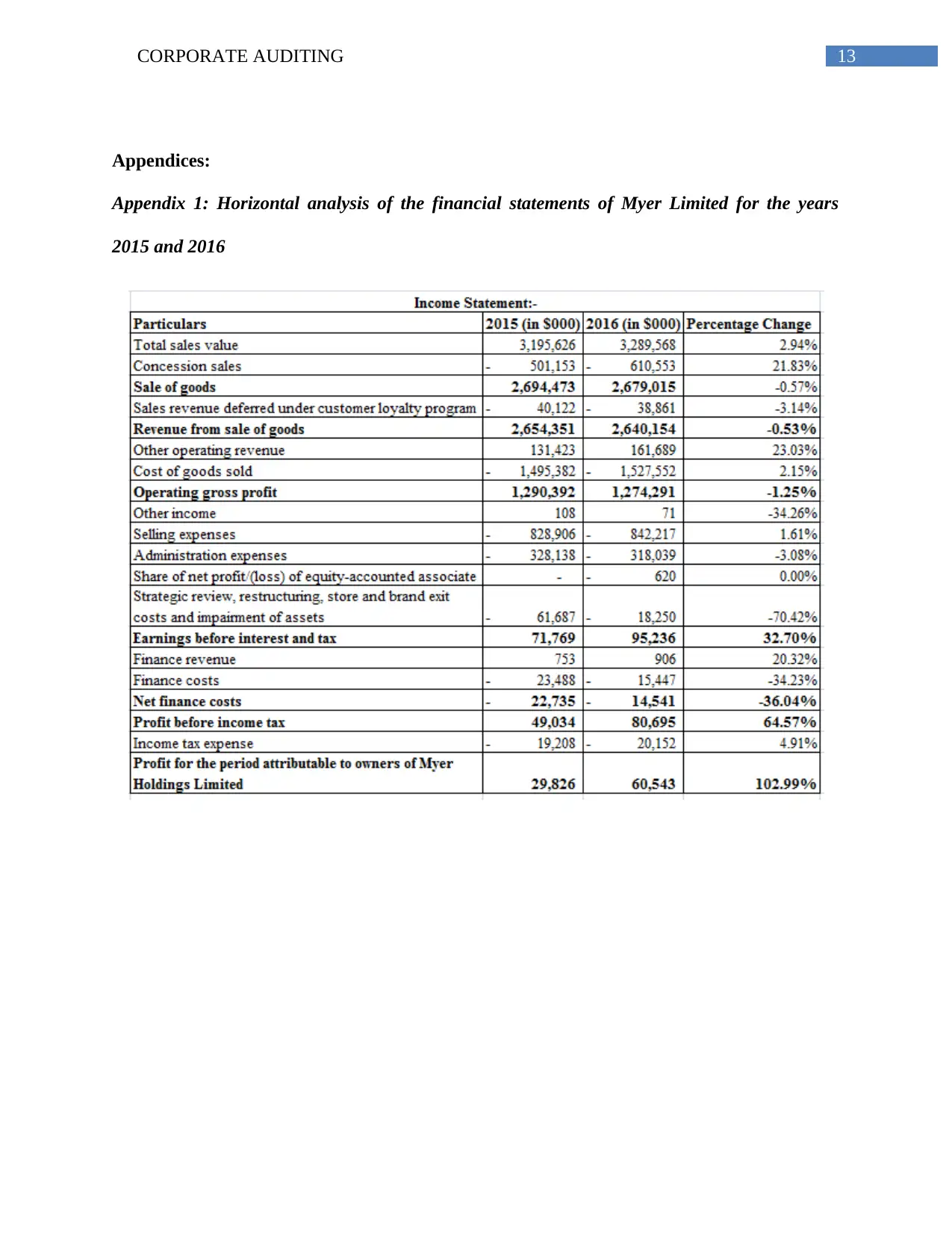
13CORPORATE AUDITING
Appendices:
Appendix 1: Horizontal analysis of the financial statements of Myer Limited for the years
2015 and 2016
Appendices:
Appendix 1: Horizontal analysis of the financial statements of Myer Limited for the years
2015 and 2016
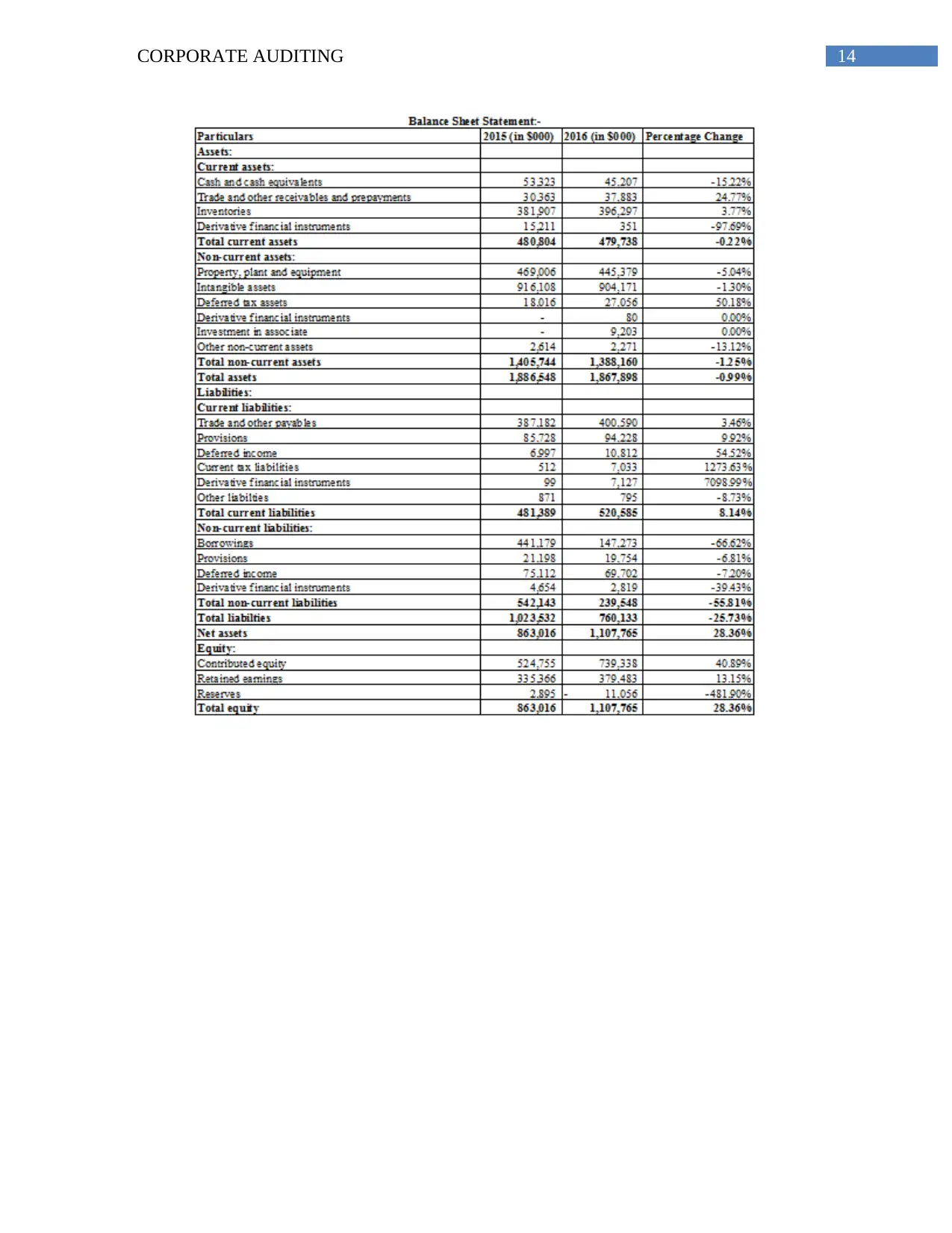
14CORPORATE AUDITING
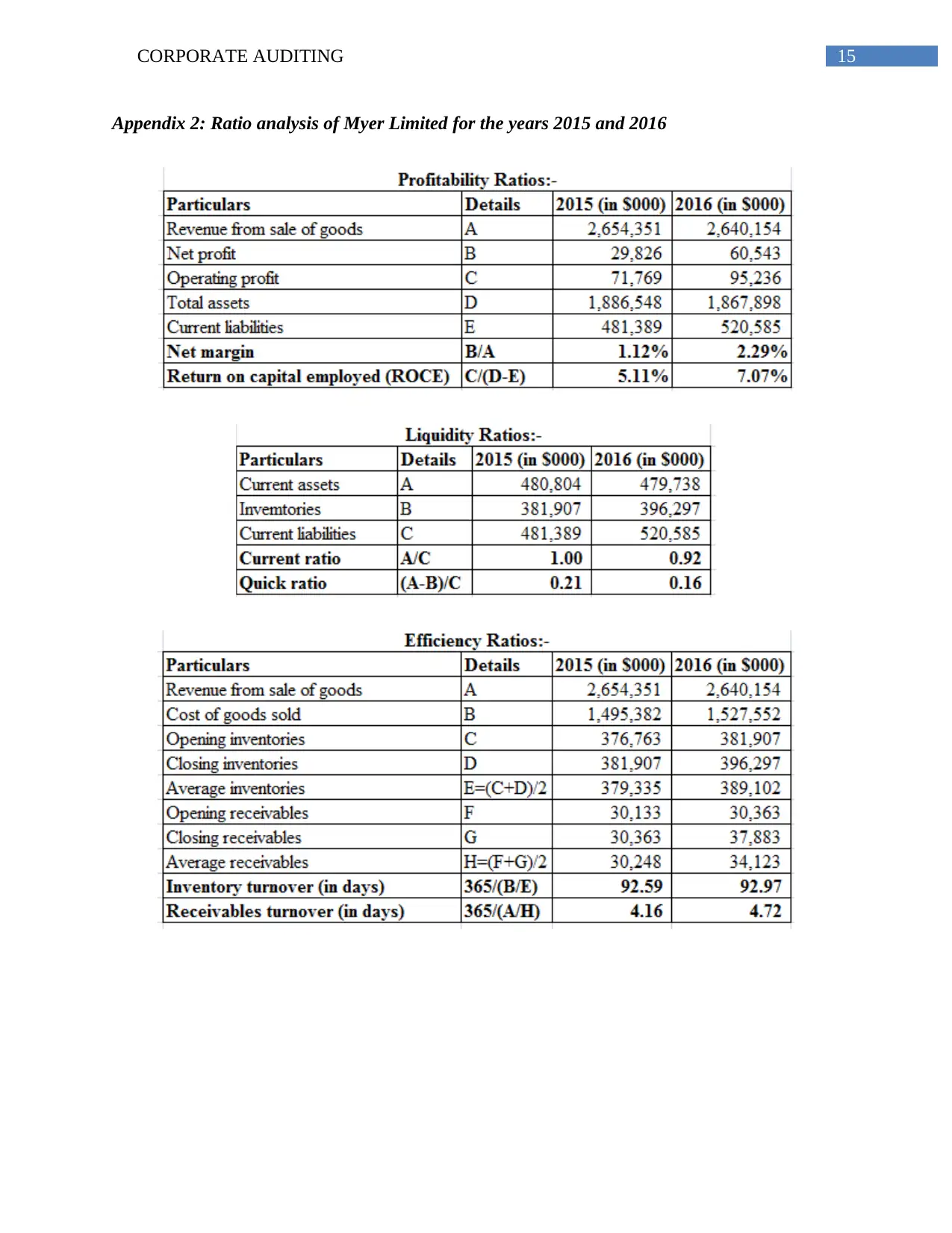
15CORPORATE AUDITING
Appendix 2: Ratio analysis of Myer Limited for the years 2015 and 2016
Appendix 2: Ratio analysis of Myer Limited for the years 2015 and 2016
Secure Best Marks with AI Grader
Need help grading? Try our AI Grader for instant feedback on your assignments.
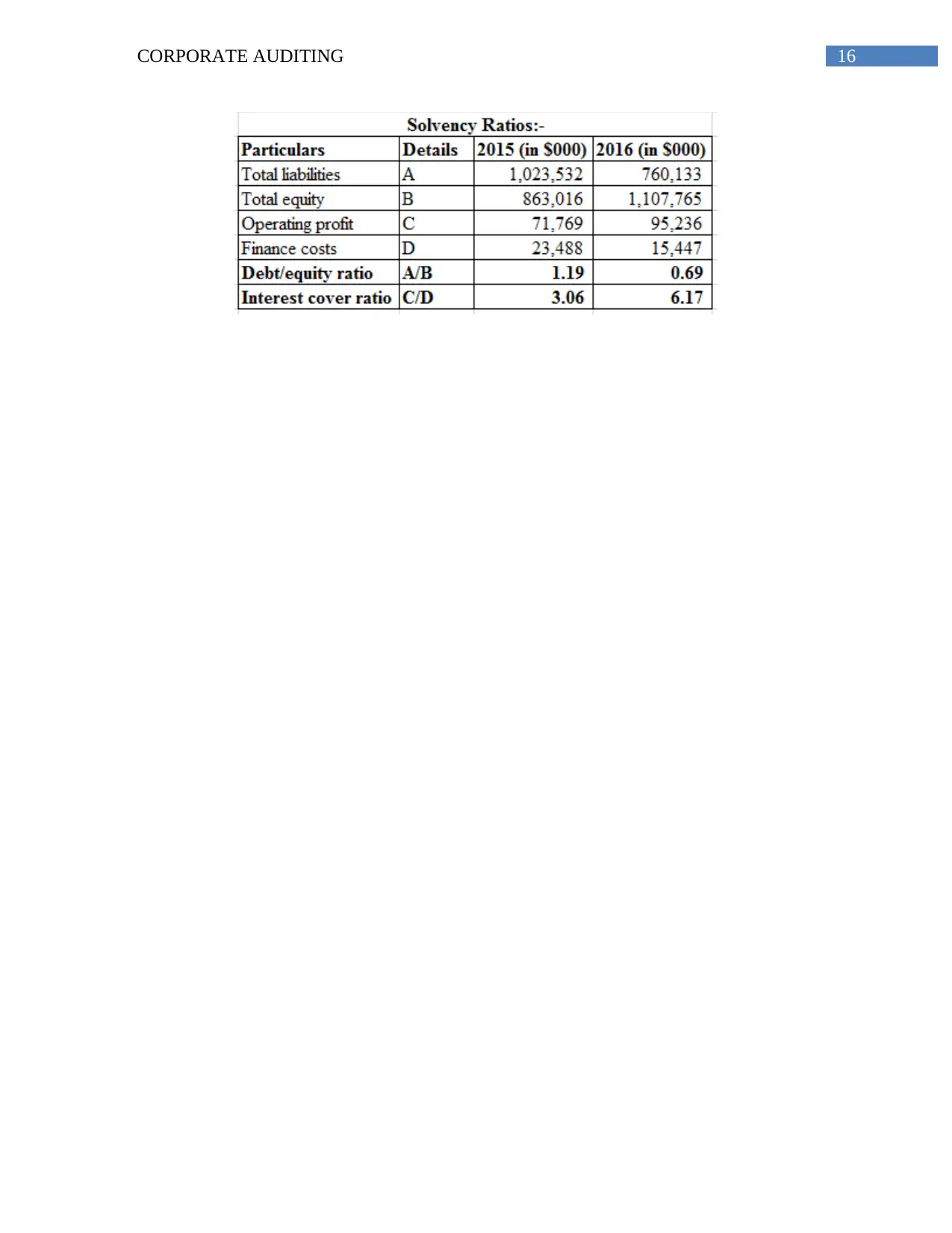
16CORPORATE AUDITING
1 out of 17
Related Documents
Your All-in-One AI-Powered Toolkit for Academic Success.
+13062052269
info@desklib.com
Available 24*7 on WhatsApp / Email
![[object Object]](/_next/static/media/star-bottom.7253800d.svg)
Unlock your academic potential
© 2024 | Zucol Services PVT LTD | All rights reserved.





